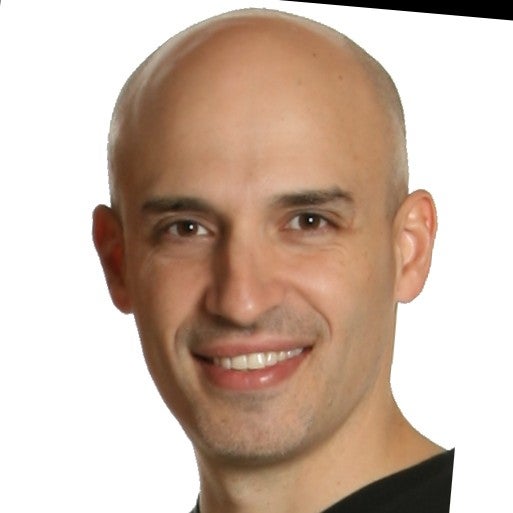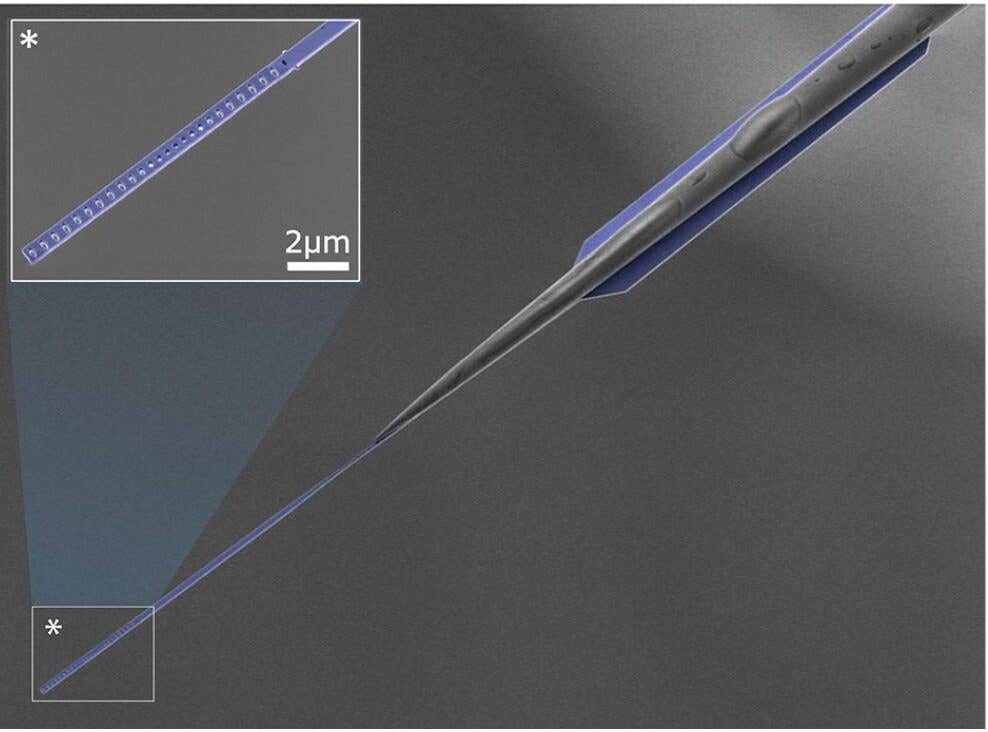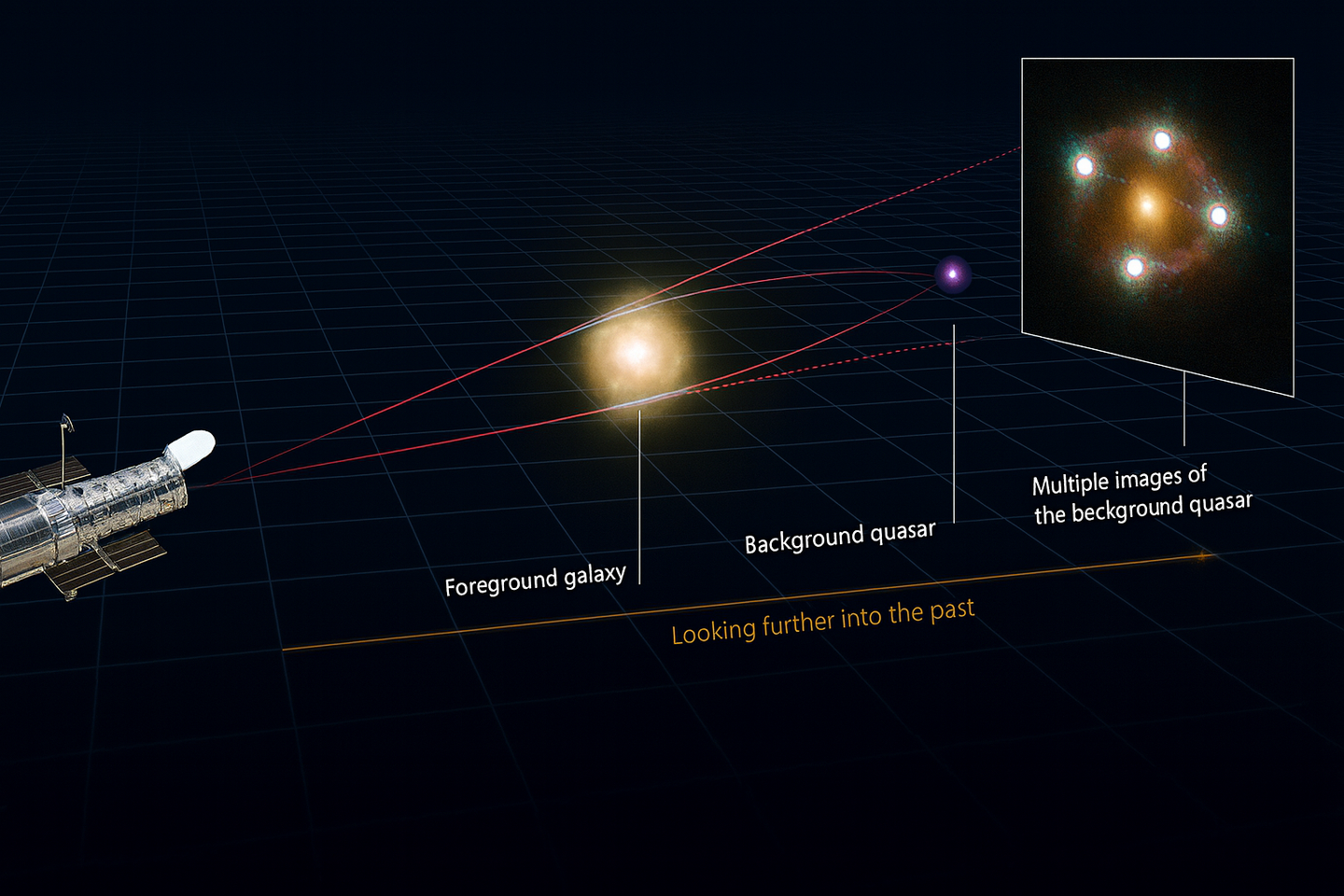Scientists built a microscopic ‘ocean’ on a silicon chip to study quantum waves
Scientists created a miniature ocean on a chip, using superfluid helium and lasers to study quantum-scale wave dynamics.

 Edited By: Joseph Shavit
Edited By: Joseph Shavit

Electron microscope image of the superfluid wave tank (blue) coupled to an optical fibre which brings laser light in and out of the device. (CREDIT: Dr. Christopher Baker)
For more than 50 years, scientists have dreamed of seeing the hidden patterns that govern the motion of nonlinear waves—the unpredictable ripples that shape tsunamis, tides, and turbulent flows. Now, a team from the University of Queensland has brought those waves into focus by shrinking an entire ocean into a chip smaller than a grain of rice.
At the university’s School of Mathematics and Physics, researchers have built the world’s smallest wave flume—a silicon beam just 100 micrometers long—coated with a film of superfluid helium only a few millionths of a millimeter thick. Using finely tuned laser light, the team can generate and observe waves that rise, bend, and break in ways that echo the vast movements of Earth’s seas.
“This is the world’s smallest wave tank,” said Dr. Christopher Baker, a member of the research team. “Because superfluid helium flows without resistance, it lets us see complex wave behaviors that regular fluids can’t show at this scale.”
The breakthrough, published in Science, transforms how physicists can study fluid motion. By compressing the physics of ocean waves into a chip-scale experiment, the researchers can now capture wave dynamics with quantum-level precision and at speeds a million times faster than traditional methods.
From Ocean Flumes to Quantum Films
Nonlinear waves are the restless, shape-shifting disturbances that drive tsunamis, tidal bores, and the churning of the atmosphere. Scientists have long used enormous tanks—some stretching hundreds of meters—to study these effects. Yet even the largest flumes can’t reproduce the extreme nonlinearities found in nature. The deeper the fluid, the weaker the effect.
The Queensland team realized the secret to unlocking these dynamics lies in the opposite direction: going shallower. Regular liquids become sticky and motionless when spread too thin, but superfluid helium behaves differently. Below its transition temperature, it flows without friction, even when only a few atoms thick. That makes it an ideal candidate for creating a microscopic version of a wave-filled ocean.
By spreading superfluid helium over a silicon beam and cooling it to near absolute zero, the researchers achieved hydrodynamic effects more than 100,000 times stronger than those seen in massive water tanks. All of it plays out in a device holding just a few femtoliters of liquid—barely enough to fill a dust mote.
Light That Makes and Measures Waves
At the heart of the setup sits a photonic crystal cavity that traps laser light, allowing it to interact with the surface of the helium film. The laser serves a dual purpose—it both stirs the liquid and records its motion. By slightly heating the cavity, the team creates a tiny flow in the superfluid known as the fountain effect. That flow, in turn, drives ripples across the helium surface.
Every shift in the wave’s height changes how the laser’s light bounces back, letting the scientists measure motion with subpicometer precision—less than one trillionth of a meter. “Using laser light to both drive and measure the waves in our system, we observed a range of striking phenomena,” said Baker.
Among those were waves that lean backward rather than forward, shock fronts that formed in a single oscillation, and solitary waves—known as solitons—that travel as dips instead of peaks. “This exotic behavior has been predicted in theory but never seen before,” Baker added.
Backward Waves and Solitary Ripples
In normal fluids, the crest of a wave moves faster than its trough, which makes the wave tilt forward before it breaks. In superfluid helium, the rules flip. Because its “gravity” arises not from Earth’s pull but from van der Waals forces between atoms, the troughs actually move faster than the crests. That reversal makes the waves lean backward, a phenomenon theorized half a century ago but never directly observed until now.
When the researchers boosted the laser power, the waves transformed even more dramatically. They steepened so fast that sharp fronts—like tiny tsunamis—formed in just milliseconds. Push the energy higher, and those shocks split into trains of solitary dips. These “hot solitons” move independently and persist over time, behaving much like the solitary waves seen in 100-meter-long ocean flumes, but here appearing on a device one millionth the size.
Simulating Nature in a Microscopic World
To understand what they saw, the team compared their data to computer models based on the classic Korteweg–de Vries equation, which describes waves and solitons in fluids and plasmas. Their custom simulations matched the experiments almost perfectly, confirming that the tiny helium flume follows the same mathematical rules as real oceans.
Professor Warwick Bowen, who leads the Queensland Quantum Optics Laboratory, said the discovery opens a new chapter in both fluid dynamics and quantum technology. “In traditional laboratories, scientists use enormous wave flumes to study shallow-water dynamics such as tsunamis and rogue waves,” Bowen said. “But these facilities only reach a fraction of the complexity of waves found in nature. Our miniature device amplifies the nonlinearities that drive these complex behaviors by more than 100,000 times.”
He explained that the chip-scale platform doesn’t just shrink ocean physics—it makes it programmable. “Because the geometry and optical fields in this system are made with the same techniques used for semiconductor chips, we can engineer the fluid’s effective gravity, dispersion, and nonlinearity with extraordinary precision,” Bowen said.
A Bridge Between Light and Liquid
The experiment unites two fields once thought worlds apart: fluid mechanics and quantum optics. By using light to both create and detect motion in a frictionless liquid, the researchers built a bridge between the macroscopic forces that shape waves and the quantum mechanics that govern matter at the smallest scales.
Previous attempts to observe nonlinear behavior in superfluids failed because the sensors lacked the resolution to see such rapid and tiny effects. The Queensland team’s optical method overcame those limits, letting them watch the full evolution of each wave as it formed, steepened, and broke—all within a few milliseconds.
Bowen believes the implications reach far beyond helium films. “Experiments on this tiny platform will improve our ability to predict the weather, explore energy cascades, and even study quantum vortex dynamics,” he said. “These are questions central to both classical and quantum fluid mechanics.”
Practical Implications of the Research
The creation of a “quantum ocean” on a chip could revolutionize how scientists study and model turbulence, wave breaking, and energy transfer in fluids.
Because the system operates a million times faster than real-world waves, it enables rapid, data-rich testing that could advance climate modeling, weather forecasting, and clean-energy technologies like wind farms and tidal systems.
The same platform could also help explore quantum phenomena such as vortex formation and the transition between order and chaos at the smallest scales, paving the way for new optical and sensing technologies.
Research findings are available online in the journal Science.
Related Stories
- MIT finds Einstein was wrong in 100-year-old wave-particle dispute with Niels Bohr
- When light waves collide something incredible happens, study finds
- Scientists use sound waves to unlock the secrets of quantum physics
Like these kind of feel good stories? Get The Brighter Side of News' newsletter.
Shy Cohen
Science & Technology Writer



